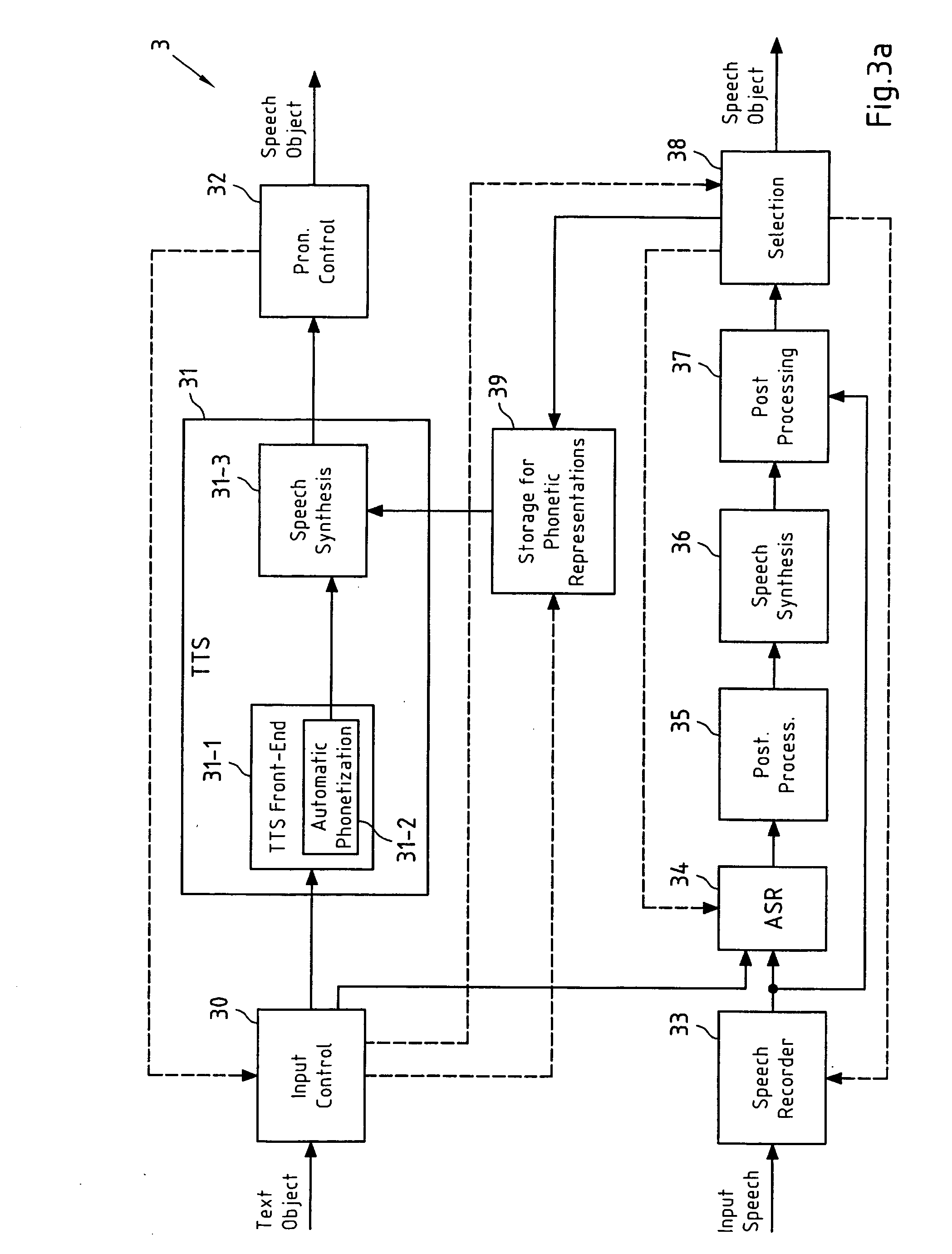Correcting a pronunciation of a synthetically generated speech object
a technology of speech object and pronunciation, applied in the field of speech object correction, can solve the problems of inability to automatically derive the correct pronunciation, inability to handle correctly, and generated speech object mispronunciation, so as to avoid future mispronunciations and memory loss
- Summary
- Abstract
- Description
- Claims
- Application Information
AI Technical Summary
Benefits of technology
Problems solved by technology
Method used
Image
Examples
first embodiment
of the Invention
[0065] In the first embodiment of the present invention, an Automatic Speech Recognition (ASR) unit generates the one or more candidate PRs of the TO based at least on a spoken representation of the TO.
[0066]FIG. 3a depicts a schematic block diagram of this first embodiment of a TTS system 3 according to the present invention. The TTS system 3 comprises a TTS unit 31 with TTS front-end 31-1, automatic phonetization unit 31-2 and speech synthesis unit 31-3. The functionality of this TTS unit 31 resembles the functionality of the TTS unit 1 of FIG. 1 and thus does not require further explanation, apart from the fact that the speech synthesis unit 31-3 of TTS system 31 is capable of receiving both PRs of a TO (sequences of one or more phonemes representing the TO) as generated by the automatic phonetization unit 31-2, and PRs of a TO stored in the storage unit 39, and that speech synthesis unit 31-3 is also capable of forwarding both the generated SO and the PR of the ...
second embodiment
of the Invention
[0104] The second embodiment of the present invention uses a TTS unit instead of an ASR unit to generate one or more candidate PRs of a TO. Nevertheless, a spoken representation of the TO is considered in the process of selecting the new PR of the TO from the candidate PRs of the TO.
[0105]FIG. 4a presents a schematic block diagram of this second embodiment of a TTS system 4 according to the present invention. The second embodiment of the TTS system 4 differs from the first embodiment of the TTS system 3 (see FIG. 3a) only by the fact that the ASR unit 34 of TTS system 3 has been replaced by a TTS front-end 44, and that a post processing unit corresponding to post processing unit 35 of TTS system 3 is no longer present in TTS system 4. Consequently. the functionality of units 40-43, and 46-49 of the TTS system 4 of FIG. 4a corresponds to the functionality of the units 30-33 and 36-39 of the TTS system 3 of FIG. 3a and thus needs no further explanation at this stage. ...
third embodiment
of the Invention
[0113] Similar to the second embodiment of the present invention, also the third embodiment of the present invention uses a TTS unit to generate one or more candidate PRs of a TO. However, in contrast to the second embodiment (see FIG. 4a), no speech input from a user is required.
[0114]FIG. 5a presents a schematic block diagram of this third embodiment of a TTS system 5 according to the present invention. The fact that no speech input of the user is processed is reflected by the fact that no speech recorder for recording an SO and no post processing unit exploiting such a recorded SO is used. The functionality of the units 50-52, 54, 56 and 58-59 of the TTS system 5 corresponds to the functionality of the units 40-42, 44, 46 and 48-49 of the TTS system 4 (see FIG. 4a) and thus does not require further explanation.
[0115] As in the first and second embodiments of TTS systems according to the present invention, it is also possible in the third embodiment of a TTS syst...
PUM
 Login to View More
Login to View More Abstract
Description
Claims
Application Information
 Login to View More
Login to View More - R&D
- Intellectual Property
- Life Sciences
- Materials
- Tech Scout
- Unparalleled Data Quality
- Higher Quality Content
- 60% Fewer Hallucinations
Browse by: Latest US Patents, China's latest patents, Technical Efficacy Thesaurus, Application Domain, Technology Topic, Popular Technical Reports.
© 2025 PatSnap. All rights reserved.Legal|Privacy policy|Modern Slavery Act Transparency Statement|Sitemap|About US| Contact US: help@patsnap.com



